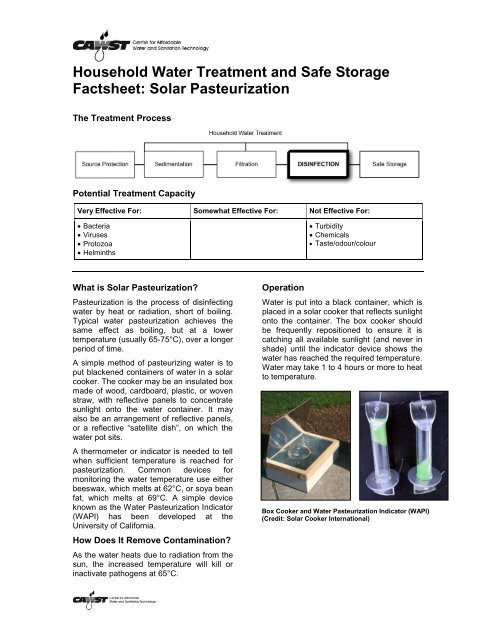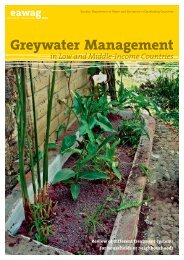Household Water Treatment and Safe Storage Factsheet: Source ...
Household Water Treatment and Safe Storage Factsheet: Source ...
Household Water Treatment and Safe Storage Factsheet: Source ...
You also want an ePaper? Increase the reach of your titles
YUMPU automatically turns print PDFs into web optimized ePapers that Google loves.
<strong>Household</strong> <strong>Water</strong> <strong>Treatment</strong> <strong>and</strong> <strong>Safe</strong> <strong>Storage</strong><br />
<strong>Factsheet</strong>: Solar Pasteurization<br />
The <strong>Treatment</strong> Process<br />
Potential <strong>Treatment</strong> Capacity<br />
Very Effective For: Somewhat Effective For: Not Effective For:<br />
Bacteria<br />
Viruses<br />
Protozoa<br />
Helminths<br />
Turbidity<br />
Chemicals<br />
Taste/odour/colour<br />
What is Solar Pasteurization?<br />
Pasteurization is the process of disinfecting<br />
water by heat or radiation, short of boiling.<br />
Typical water pasteurization achieves the<br />
same effect as boiling, but at a lower<br />
temperature (usually 65-75°C), over a longer<br />
period of time.<br />
A simple method of pasteurizing water is to<br />
put blackened containers of water in a solar<br />
cooker. The cooker may be an insulated box<br />
made of wood, cardboard, plastic, or woven<br />
straw, with reflective panels to concentrate<br />
sunlight onto the water container. It may<br />
also be an arrangement of reflective panels,<br />
or a reflective “satellite dish”, on which the<br />
water pot sits.<br />
A thermometer or indicator is needed to tell<br />
when sufficient temperature is reached for<br />
pasteurization. Common devices for<br />
monitoring the water temperature use either<br />
beeswax, which melts at 62°C, or soya bean<br />
fat, which melts at 69°C. A simple device<br />
known as the <strong>Water</strong> Pasteurization Indicator<br />
(WAPI) has been developed at the<br />
University of California.<br />
How Does It Remove Contamination?<br />
As the water heats due to radiation from the<br />
sun, the increased temperature will kill or<br />
inactivate pathogens at 65°C.<br />
Operation<br />
<strong>Water</strong> is put into a black container, which is<br />
placed in a solar cooker that reflects sunlight<br />
onto the container. The box cooker should<br />
be frequently repositioned to ensure it is<br />
catching all available sunlight (<strong>and</strong> never in<br />
shade) until the indicator device shows the<br />
water has reached the required temperature.<br />
<strong>Water</strong> may take 1 to 4 hours or more to heat<br />
to temperature.<br />
Box Cooker <strong>and</strong> <strong>Water</strong> Pasteurization Indicator (WAPI)<br />
(Credit: Solar Cooker International)
















